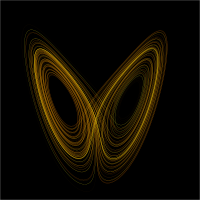
Photo from wikipedia
Over 50 years since Lorenz’s 1963 study and a follow-up presentation in 1972, the statement “weather is chaotic” has been well accepted. Such a view turns our attention from regularity… Click to show full abstract
Over 50 years since Lorenz’s 1963 study and a follow-up presentation in 1972, the statement “weather is chaotic” has been well accepted. Such a view turns our attention from regularity associated with Laplace’s view of determinism to irregularity associated with chaos. In contrast to single-type chaotic solutions, recent studies using a generalized Lorenz model (GLM) have focused on the coexistence of chaotic and regular solutions that appear within the same model using the same modeling configurations but different initial conditions. The results, with attractor coexistence, suggest that the entirety of weather possesses a dual nature of chaos and order with distinct predictability. In this study, based on the GLM, we illustrate the following two mechanisms that may enable or modulate two kinds of attractor coexistence and, thus, contribute to distinct predictability: 1) the aggregated negative feedback of small-scale convective processes that can produce stable nontrivial equilibrium points and, thus, enable the appearance of stable steady-state solutions and their coexistence with chaotic or nonlinear oscillatory solutions, referred to as the first and second kinds of attractor coexistence; and 2) the modulation of large-scale time-varying forcing (heating) that can determine (or modulate) the alternative appearance of two kinds of attractor coexistence. Based on our results, we then discuss new opportunities and challenges in predictability research with the aim of improving predictions at extended-range time scales, as well as subseasonal to seasonal time scales.
Journal Title: Bulletin of the American Meteorological Society
Year Published: 2021
Link to full text (if available)
Share on Social Media: Sign Up to like & get
recommendations!